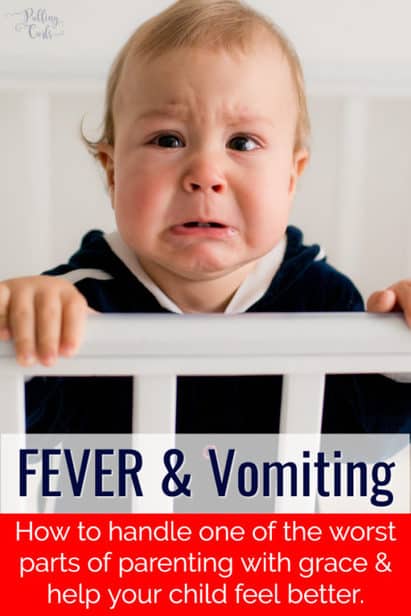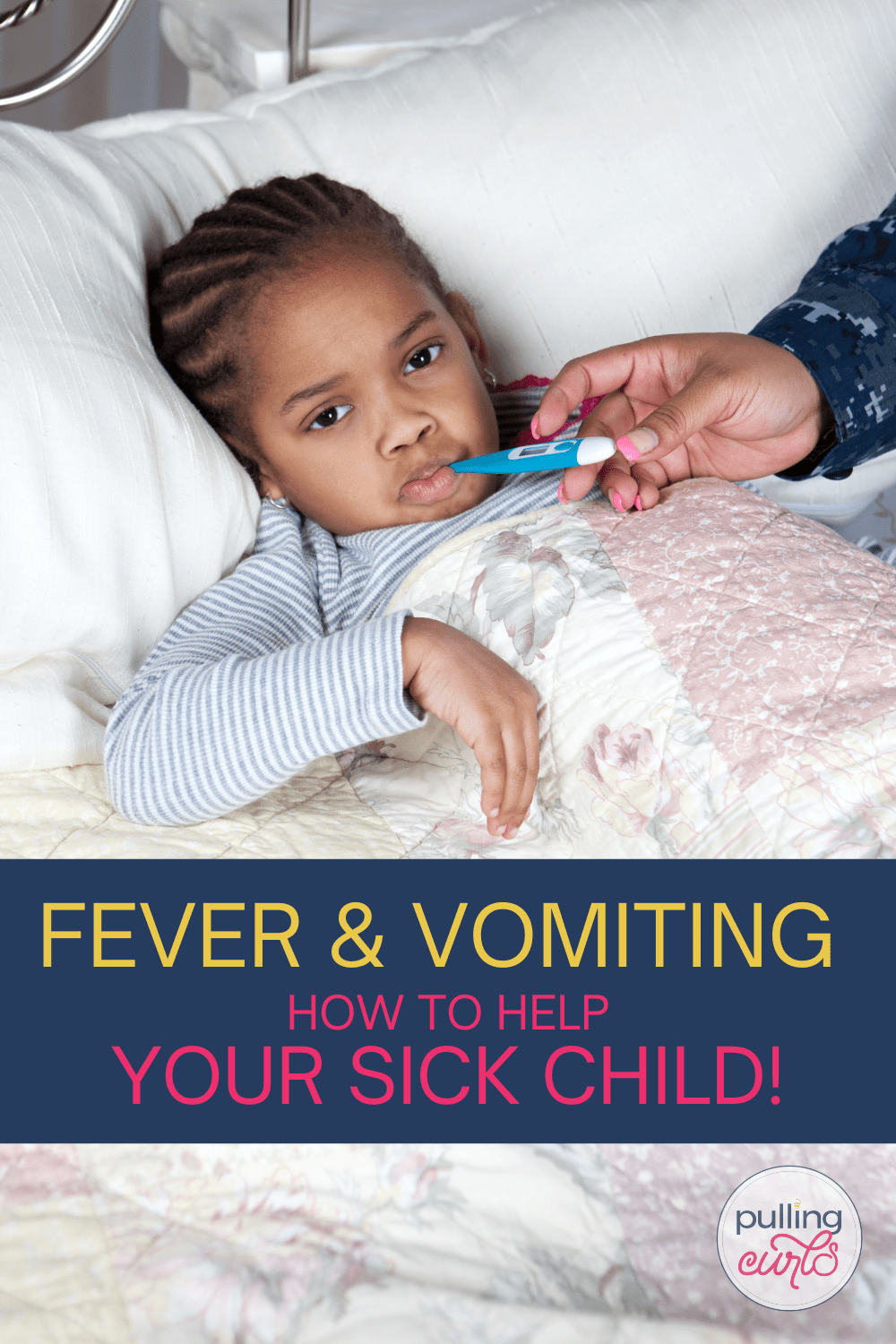In this post, we’ll talk about fever and vomiting in children — babies, infants toddlers, young children, older children, and more. When to worry if it’s meningitis and what to even do with adults?

Fever & Vomiting in Child
You hold your baby close, the fever is high. They’re miserable, you’re miserable for them. Their hot little head next to yours, beaded with sweat. You wonder how the night will go — when the unthinkable happens… Your child vomits all over you. Fever & vomiting is one of my least favorite parts as a parent, but they often go together like Abbott and Costello. Just not nearly as funny. How can you keep their temperature down if they can’t get medicine in? Let’s find out.
Fever in Babies & Infants
Fever is usually defined as anything above 100.4 — yes, your baby might run 98.7 as all the books say, but normal fluctuations including outside temperature, number of layers you have them in, as well as where they are in their circadian rhythms can make it go up and down throughout the day.
Babies under 2 months of age should not have a fever. If they do, you need to take them to the pediatrician. Call to make an appointment right now. They just don’t have the germ-fighting ability that an older child will have and their risk of dehydration is higher.
For young babies from 2 to six months of age, you need to be really thoughtful about fevers. If they’re too high or concerning, getting medical care is never a bad option. Check with your doctor about what over-the-counter medicines you can give your baby, and at what point you should call them.
How to check for fever in children
An axillary thermometer is the easiest way to take a baby or child’s temperature. It’s less invasive and the easiest to get. However, the gold standard for a temperature is a rectal temperature. However, if you plan to take a rectal temp, make sure you have a thermometer meant for that. It should have safeguards so that you don’t go too deep. Really big problems can happen if you take a rectal temperature incorrectly, so be sure to follow the packaging instructions.
Pro tip: I just use axillary, and that’s what we use in the hospital.
How to reduce a fever in babies & children
Fever is usually helped by a couple of things:
- Hydration
- Medication
Medicine for fever and vomiting
Fever is usually reduced in a number of ways, but the #1 way to reduce it for children is acetaminophen or ibuprofen (ibuprofen is not for small babies).
You can find it easily as a liquid (and you likely take it as a tablet when you have a headache, they also have chewable options).
But, the main problem with babies is that they often won’t eat at the same time they don’t feel well. So, not only do you have a miserable child, but you also don’t know how to get anything in them to help them feel better.
Acetaminophen has been used for years in the treatment of fever, aches, and pains in kids. Ask your child’s doctor about it on your next visit if you have further questions.
Pro Tip: Recent literature shows that allowing a fever to rage may have some positive effects towards fighting off the illness, so don’t feel like you have to give Tylenol. I would just see how they’re doing and talk to your healthcare provider if you have questions.
Fever & Vomiting
What can you do if your child refuses the liquid medication or if they’re vomiting, so it won’t stay down anyway?
For us, we’ve always used FeverAll. FeverAll is acetaminophen but in a suppository form. For those who’ve never had one, — a suppository goes into your rectum and is quickly absorbed that way.
Pro Tip: We (nurses) actually give a fair number of drugs in suppository form in the hospital. When people are sick, it’s often the best way to get medication in them. Even if the thought makes you cringe.
Putting in a suppository is easy and your baby won’t cringe like you do since you’re always wiping their cute bums. 🙂 Just follow the instructions in the package.
With FeverAll you don’t have to be worried if your child “got it all” (hard to know if they throw up within the hour that they get the medication).
We always kept FeverAll on hand for our kids. I have even used it on my daughter (who is 9) because she will get a severe headache and throw up — the only way to get anything for the headache in her is a suppository.
Fever and vomiting in a baby/infant
Unless your child feels miserable, some of the most recent research shows that allowing the fever to continue (vs giving medication) can be helpful. Make sure you’re getting them plenty of fluids – fruit juice, sports drinks, clear fluids, and breast milk, all of these can help prevent dehydration. I would start with small amounts of fluids to begin with to make sure they can keep it down. I don’t recommend ice chips or water, even warm water until they’ve been able to keep things down. Water seems to really increase stomach aches.
However, babies & infants can get VERY high fevers which can make them miserable and you quite uncomfortable as well. You want to make sure that a dose of Tylenol is bringing it down — I have tons more info on this in my children’s fever post.
I would follow the protocol in my stomach flu post to only give clear liquids after an hour. Trying to hydrate them, but not over-hydrating them to where they vomit again is a fine balance you’ll have to watch.
Alarm tip: If your child is under 2 months with a fever, you need to call your doctor.
Fever and vomiting 3-year-olds & toddlers
It’s very similar to how you deal with a baby/infant, except that at this point they can hopefully give you some indication of how they feel.
They may also beg for water after they throw up. DO NOT GIVE IN. Nothing by mouth for the first hour after they vomit. If they’re miserable with the taste they could swish, but encourage them to spit it out. Their stomach needs time to rest.
If they’re just miserable, you could try regular liquid Tylenol (after the hour), that small amount shouldn’t do anything, but you can also try that FeverAll suppository as well.
Fever and vomiting blood
If you vomit frequently, you could see small streaks of blood in your vomit. As long as it’s a small amount and bright red, I’d just keep an eye on it — but if it changes to look more like coffee grounds or is a larger amount of bright red blood, you should call your doctor or head to insta care or the Emergency Room.
Vomiting in children
If you’re looking for more info on vomiting in children, I follow a very specific diet so that my kids get over it quite quickly. Parents can do a lot to make this worse — so, follow this stomach flu diet and your little one should feel better soon. The brat diet is gentle bland foods that shouldn’t irritate their stomach no matter your child’s age.
How to stop vomiting in children
The best way to stop it is to allow the stomach to rest.
EXCLUSIVE CODE: Use coupon code PULLINGCURLS to get $20 off The Bosch Mixer (also in stainless steel), Classic Grain Mill & Harvest Grain Mill, at Nutrimill.com
My Favorites:
🤑 The Artiste is a gem of a mixer at a great price.
💚 The Baker’s pack is what I use at my house, the paddles and the scraper make this my favorite mixer!
(💲💲💲 Use code PULLINGCURLS on either of those too to save $20)
It is important that kids expel the virus/cause of whatever is making them throw up. I don’t recommend anything for their nausea as there is a reason our bodies make us vomit — and that’s to get out whatever is bad in it. Whether it’s a stomach virus, stomach pain, or a random stomach bug our bodies want those bad things out.
Following the tips in my stomach flu post will help a lot.
Vomiting causes
Vomiting can happen for a few reasons. A common cause can be –
- Viral infection (like the stomach flu)
- Food poisoning
- Kids often get so much mucus in their tummies with a cold/flu that they will vomit to get it out
- Other serious illness – but those are the most common.
High fever and vomiting in adults
The most important thing is to rehydrate yourself as soon as possible. I follow my stomach flu diet as well, and it helps. Hydration will help fevers, as will Tylenol. I don’t recommend ibuprofen too much when vomiting is happening. Really watch for signs of dehydration, severe dehydration can cause other side effects.
Nausea and headache
It isn’t unusual to have nausea with a headache. I usually treat that with Tylenol and rest as possible.
Could it be Meningitis?
The #1 symptom of meningitis is neck pain. Not like a stiff neck but actual pain when you move your head. If your child is having severe neck pain with these other symptoms, you’d want to get medical help.
If you liked that post –be sure to grab my stomach flu tips — and check out my other family health tips below that!
[thrive_leads id=’32113′]
[pt_view id=”d218d8581b”]





Mikey says
Great blog! Thanks for sharing. If my child has a fever and months old I think it is also good to consult to the doctor.
Hilary says
yes, of course!